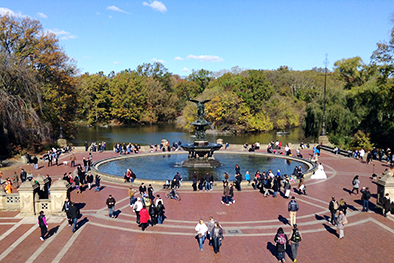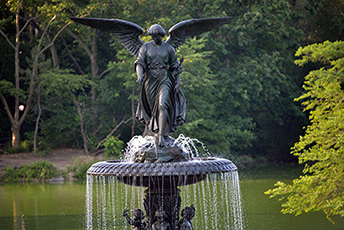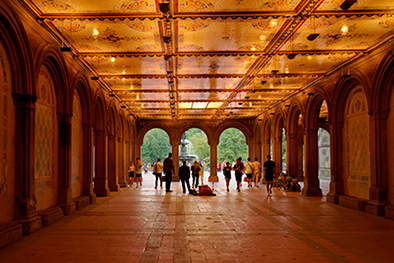March 12th, 2024
Part Four: Bethesda Terrace, Arcade, and Fountain
 The history of landscape design is a compilation of the dominant character of places and within them their particular aspects as derived from nature, architecture, ornamentation, and sometimes the presence of works of art within their boundaries. In my September 8, 2023 posting I wrote about Jacob Wrey Mould, whose nature-based design aesthetic and facility in integrating ornamentation and architectural design can be especially admired in the twin stairways flanking the sides of the Bethesda Terrace Arcade, with their side panels of carved sandstone depicting the four seasons of the year through integrated compositions of intertwining vegetation carved in high relief.
The history of landscape design is a compilation of the dominant character of places and within them their particular aspects as derived from nature, architecture, ornamentation, and sometimes the presence of works of art within their boundaries. In my September 8, 2023 posting I wrote about Jacob Wrey Mould, whose nature-based design aesthetic and facility in integrating ornamentation and architectural design can be especially admired in the twin stairways flanking the sides of the Bethesda Terrace Arcade, with their side panels of carved sandstone depicting the four seasons of the year through integrated compositions of intertwining vegetation carved in high relief.
Mould designed the circular pool and the plinth upholding the sculpture of an eight-foot-tall angel with outstretched wings and oversaw its sculpting as well as that of the attendant four cherubs by the neoclassical sculptor Emma Stebbins (1815–1882), lover and life partner of the prominent nineteenth-century actor Charlotte Cushman (1816–1876 and sister of Henry E. Stebbins, chairman of the Central Park Commissioners’ Committee on Statuary, Fountains, and Architectural Structures.
_
The first woman of her generation to become a professional artist, Stebbins was charged with modeling and then casting in bronze a statue of the “Angel of the Waters” inspired by the New Testament passage in the Book of John describing a heavenly being sent by God to stir and thereby confer healing powers upon the waters of the pool at the place known as Bethesda on the outskirts of Jerusalem.

Angel of the Waters. Bethesda Fountain in Central Park. Photograph courtesy of Sara Cedar Miller.
Originally symbolizing the 1842 public health victory for New York City with the building of the Croton Aqueduct, which brought clean potable water to its cholera-plagued population, the Angel’s symbolic power was believed to extend beyond the healing of disease and disability to become a representation of love and religious rebirth. With outstretched wings, she seems to hover like a seabird, alighting on a mass of rock, from which the water gushes in a natural manner, falling over the edge of an upper basin, slightly veiling, but not concealing, four four-foot-high figures. Modeled in Rome in 1864 and cast in Munich in 1872, these statues of cherubs, which were secured in place on the plinth upholding the Fountain in 1873 were considered to be emblematic of the blessings of Temperance, Purity, Health, and Peace. The author of the 1872/73 Central Park Commissioners Report to New York City’s Department of Parks explains, “This subject seems not inappropriate in connection with a fountain; for, although we have not the sad groups of blind, halt, and withered waiting to be healed by the miraculous advent of the angel as described in the Bible, we have no less healing, comfort, and purification, freely sent to us through the blessed gift of clear, wholesome water, which to all the countless homes of this great city, comes like a visitant, not at stated seasons only, but day by day.”
In 1980, when the recently incorporated Central Park Conservancy became responsible for funding and executing restoration projects and improving the daily management of the park, such symbolically beneficent beauty of the center of Central Park was no longer apparent. The fountain was dry and the Terrace had become the preferred weekend “concert ground” for buskers whose loud beating of bongo drums were an was a regular annoyance to the residents of apartments on Central Park West and Fifth Avenue. In addition, there was a host of illegal cheap-tourist-merchandise vendors whose turf was the Terrace, and graffiti was slathered across the beautiful carved stonework of the exterior surfaces of the Arcade. It was at this time that I gained the firmness of will and sufficient donor support to stake out a “first-things-first” project for the new public-private park partnership.
For the original logo of the Central Park Conservancy I had selected the image of the Bethesda Angel, and the restoration of the sculpture atop the fountain and the renovation of its surrounding Terrace and embracing landscape logically became the Central Park Conservancy’s first major multi-focused, multi-year capital project. In 1980–1981 during the initial phase of the fulfillment of its omnibus plan to rebuild Central Park according to the principles governing its original design, the Bethesda Fountain received new plumbing and the surface of the fountain was cleaned with a chemical that removed a crust of copper sulfate, after which its original patina of bronze was burnished to a golden hue.
_
 Over the past three decades, in addition to the re-plumbing and re-patinizing of the fountain, there has been the repair of the broken stonework forming coping blocks for the low wall defining the circumferential edge of the Bethesda Terrace, which had been cracked and toppled by mud slides from the eroding soil of the slopes on its grassy perimeter. Moreover, there was the replacement according to their original decorative pattern of the broken encaustic ceiling tiles of the Arcade with replicas made by the same Minton Tile Company in Stoke-on-Trent according to their original decorative pattern; and the repair of its flooring, the surface of which surface had been cracked by the underground spreading of tree roots.
Over the past three decades, in addition to the re-plumbing and re-patinizing of the fountain, there has been the repair of the broken stonework forming coping blocks for the low wall defining the circumferential edge of the Bethesda Terrace, which had been cracked and toppled by mud slides from the eroding soil of the slopes on its grassy perimeter. Moreover, there was the replacement according to their original decorative pattern of the broken encaustic ceiling tiles of the Arcade with replicas made by the same Minton Tile Company in Stoke-on-Trent according to their original decorative pattern; and the repair of its flooring, the surface of which surface had been cracked by the underground spreading of tree roots.
To sum up: The bricks of the floor of the Terrace were reset after a thorough cleaning; repair of the broken pieces of the Terrace’s border coping and their restoration to the original positions they occupied occurred; and the resodding of the Terrace’s abutting slopes curving down to the Terrace with blankets of grass banked by rhododendrons from the park’s 72nd Street cross-drive and, at the bottom of Cherry Hill next to the lakeside path leading to Bow Bridge a bed of wild roses. In such ways as these has the Angel of the Waters been reunited with her immediate, and further embracing, surroundings.
The surface of the fountain was cleaned with a chemical that removed its crust of copper sulfate, after which it was burnished to a golden-bronze hue. In 1980–1981 during the Conservancy’s first phase of the fulfillment of its the preliminary stage of its management and restoration plan to rebuild Central Park according to the principles governing its original design and providing ongoing management by a zone gardener.
The entire scope of the job included the stone coping around the Terrace along with the landscape embracing it as well as the staircase uniting the Arcade with the Mall, and the replacement of the broken encaustic, ornamental ceiling tiles of the Arcade connecting Bethesda Terrace with the Mall. Because many of the tiles were missing or cracked, it was necessary to commission the Minton Tile Company in Stoke-on-Trent, which is still in business, to replicate the original tiles, which were then fastened to suspended steel rods to form a perfect replica of Jacob Wrey Mould’s colorful ornamental ceiling.
Two weeks ago I took an early spring walk in the park with Ted and my granddaughter Caroline Towbin to the Bethesda Terrace to stand in reverie about the past and hopes for the future while gazing at the Angel with wings outspread above a bridal couple posing for photographs. Then we stood for a while on the north edge of Terrace looking straight-on across the lake at the 38-acre Ramble, the woodland known for its sinuous paths leading toward the Belvedere through a forest of trees that are a magnet for birdwatchers every spring before following our line of vision across the waters of the Lake via the Bow Bridge, the nexus linking the east and west arms of the Lake.
We then headed across the bridge to continue our walk back home through the Ramble, stopping among other mobile-phone-cum-camera-toting park visitors gazing across the water toward Central Park West and 72nd Street at the Dakota, the storied landmark that is the city’s first posh residential apartment house. Gazing down at the sunlight-washed water, we counted the couples in rowboats passing beneath the Bow Bridge. They, like us, were recipients of the warm air-blown beneficence of the hovering fountain Angel of Bethesda, whose healing power can be experienced in every water fountain throughout the park as well as all the water faucets in every building in the great city that this Texas girl calls her ardently adopted home for the past fifty-nine years.
Share
